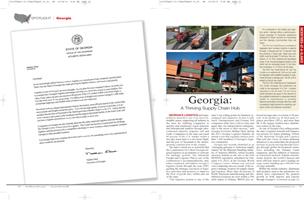
 Georgia’s logistics and transportation network is one of its most formidable assets, supporting all industry in the state by enabling companies to quickly and seamlessly reach domestic and international markets through interconnected airports, seaports, rail and roads. Companies in the state can reach 80 percent of the U.S. market within a two-day truck haul or a two-hour flight, and the port of Savannah is the fastest-growing container port in the country.
Georgia’s logistics and transportation network is one of its most formidable assets, supporting all industry in the state by enabling companies to quickly and seamlessly reach domestic and international markets through interconnected airports, seaports, rail and roads. Companies in the state can reach 80 percent of the U.S. market within a two-day truck haul or a two-hour flight, and the port of Savannah is the fastest-growing container port in the country.
The state’s assets are so powerful that the Commission for a New Georgia targeted logistics as an industry to cultivate for strategic growth. The Statewide Freight and Logistics Plan is one of the commission’s recommendations, and, when completed, will address Georgia’s logistics needs through the year 2050, guiding the strategic execution of logistics activities and projects to improve the flow of goods into, within and out of the state.
“Our logistics system is one of the state’s top selling points for business recruitment and expansion. In fact, it sells itself. Entrepreneurs and Fortune 500 companies alike have told us time and again that our transportation infrastructure is the secret to their success,” said Georgia Governor Nathan Deal, during the 2011 Georgia Logistics Summit, an annual event that regularly attracts more than 1,200 members of Georgia’s logistics community.
Georgia was recently identified as an “emerging gateway to American supply chains” by the Material Handling Industry of America (MHIA), which recently selected  Atlanta as the site of the first MODEX exposition, scheduled for February 6-9, 2012, at the Georgia World Congress Center. Atlanta was selected over competing sites as a result of the region’s strategic location for supply chains and logistics. More than 40 percent of North American manufacturing and distribution locations are now within a 500 mile radius of Atlanta. MHIA also selected Georgia since it is home to 90 percent of the global top 25 third party logistics providers (3PLs), and more than 48 of the largest retailers have distribution centers in the state.
Atlanta as the site of the first MODEX exposition, scheduled for February 6-9, 2012, at the Georgia World Congress Center. Atlanta was selected over competing sites as a result of the region’s strategic location for supply chains and logistics. More than 40 percent of North American manufacturing and distribution locations are now within a 500 mile radius of Atlanta. MHIA also selected Georgia since it is home to 90 percent of the global top 25 third party logistics providers (3PLs), and more than 48 of the largest retailers have distribution centers in the state.
As one of Georgia’s key selling points, the state’s logistics network will remain a top priority for future planning. Efforts of the Statewide Freight and Logistics Plan will also focus on future planning initiatives to accommodate the projected increase in goods moving through Georgia through global development initiatives including the Panama Canal expansion, and the addition of runways at Hartsfield-Jackson Atlanta International Airport, the world’s busiest and most efficient airport and a leading air cargo center, handling up to 900,000 tons of cargo annually.
Within the metals industry, aluminum mill products used in the automotive industry have experienced the greatest growth in both imports and exports through Georgia’s Garden City Terminal at the Port of Savannah since the beginning of fiscal year 2010. Georgia’s ports and inland port have contributed greatly to the success of the rapidly growing KIA manufacturing plant that began product just two years ago.
 Georgia’s container port in Garden City has seen a 149 percent increase in exports of the automotive commodity group since 2007. Automotive commodities currently make up six percent of the container export traffic in the country’s fastest growing container port; increasing 43 percent between fiscal year 2010 and 2011. Likewise on the import side, automotive commodities were the fastest growing import commodity increasing by 36 percent from 2010 to 2011, and accounting for eight percent of the Garden City Terminal’s imports.
Georgia’s container port in Garden City has seen a 149 percent increase in exports of the automotive commodity group since 2007. Automotive commodities currently make up six percent of the container export traffic in the country’s fastest growing container port; increasing 43 percent between fiscal year 2010 and 2011. Likewise on the import side, automotive commodities were the fastest growing import commodity increasing by 36 percent from 2010 to 2011, and accounting for eight percent of the Garden City Terminal’s imports.
This increase is largely due to the location of KIA Motors Manufacturing Georgia (KMMG), which began mass production in late 2009. Since that time the plant has attracted several auto parts suppliers from Korea and other parts of the country, and to date, these suppliers have created more than 4,000 jobs in Georgia. The KIA plant has exceeded its timeline for production goals, having already added another line of production to the plant.
This rapid and tremendous growth has been handled seamlessly with the aid of the Georgia Ports Authority, who before production began, helped to navigate 3,500 tons of equipment to build two stamping presses. The equipment was transported from Savannah to KIA Motors Manufacturing Georgia’s $1.2 billion facility, where it was assembled into two large presses that will be used to form various panels for KIA vehicles.
Some of the larger pieces weigh up to 125 tons and require special arrangements for its transportation across Georgia.
“It takes quite an effort between Kia and various state agencies to coordinate the transport of such a large shipment, but Georgia’s ability to facilitate such an effort is one of the main reasons we’re here,” said Randy Jackson, director for HR and Administration at KIA Motors Manufacturing Georgia Inc.
The initial shipment left Masan, Korea, in the summer of 2008 on the Leopold Staffs and navigated across the Pacific Ocean, through the Panama Canal, across  the Gulf of Mexico, around Florida and up the coast to the Port of Savannah.
the Gulf of Mexico, around Florida and up the coast to the Port of Savannah.
Once the equipment was unloaded from the ship, the items were transported another 300 miles to KMMG in West Point in 128 separate loads via a fleet of trucks that included dual-lane trailers and a specialized 19-axle truck for the largest pieces of the presses. And this entire process repeated itself earlier this year as KIA gears up high customer demand. Since the 2011 Sorento hit the market, it has led KIA sales in the United States. Kia sold more than 11,000 Sorentos in March, it said.
The KMMG plant in West Point is just one example of how Georgia’s well-networked system of logistics is a competitive asset for businesses in the state, which cannot be found in many other states in the nation. As a global hub of logistics, Georgia also supports supply chain and logistics through the Georgia Center of Innovation for Logistics, which is a leading industry resource in the state that connects businesses with academia, industry expertise and other unique resources to help them succeed in Georgia and in markets around the world.
“Georgia’s logistics infrastructure is very much its own ecosystem that undergirds all industry in Georgia and abroad, and makes it possible for us to effectively attract new and expanding businesses to Georgia,” said Page Siplon, director of the Georgia Center of Innovation for Logistics. “Our system of logistics works as well as it does due in large part to the partnerships we have with private industry, and our state’s commitment to ensure logistics remains a key competitive asset for Georgia.”

